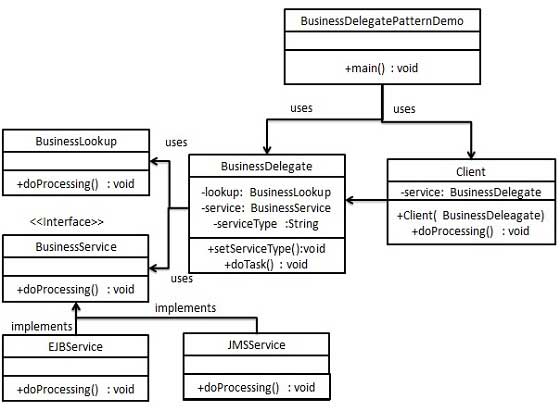- 业务代表模式
- 设计模式-主页
- 设计模式-概述
- 设计模式-工厂模式
- 抽象工厂模式
- 设计模式-Singleton模式
- 设计模式-生成器模式
- 设计模式-原型模式
- 设计模式-适配器模式
- 设计模式-桥梁模式
- 设计模式-过滤器模式
- 设计图案-复合图案
- 设计图案-装饰图案
- 设计图案-立面图案
- 设计图案-飞线图案
- 设计模式-代理模式
- 责任链模式
- 设计模式-命令模式
- 设计模式-解释器模式
- 设计模式-迭代器模式
- 设计模式-中介模式
- 设计模式-Memento模式
- 设计模式-观察者模式
- 设计模式-状态模式
- 设计模式-空对象模式
- 设计模式-战略模式
- 设计模式-模板模式
- 设计模式-访客模式
- 设计模式-MVC模式
- 业务代表模式
- 复合实体模式
- 数据访问对象模式
- 前控制器模式
- 拦截过滤器模式
- 服务定位器模式
- Java传输对象模式
业务代表模式
Business Delegate Pattern is used to decouple presentation tier and business tier. It is basically use to reduce communication or remote lookup functionality to business tier code in presentation tier code. In business tier we have following entities.
Client - Presentation tier code may be JSP, servlet or UI java code.
Business Delegate - A single entry point class for client entities to provide access to Business Service methods.
LookUp Service - Lookup service object is responsible to get relative business implementation and provide business object access to business delegate object.
Business Service - Business Service interface. Concrete classes implement this business service to provide actual business implementation logic.
Implementation
We are going to create a Client, BusinessDelegate, BusinessService, LookUpService, JMSService and EJBService representing various entities of Business Delegate patterns.
BusinessDelegatePatternDemo, our demo class, will use BusinessDelegate and Client to demonstrate use of Business Delegate pattern.

Step 1
Create BusinessService Interface.
BusinessService.java
public interface BusinessService {
public void doProcessing();
}
Step 2
Create concrete Service classes.
EJBService.java
public class EJBService implements BusinessService {
@Override
public void doProcessing() {
System.out.println("Processing task by invoking EJB Service");
}
}
JMSService.java
public class JMSService implements BusinessService {
@Override
public void doProcessing() {
System.out.println("Processing task by invoking JMS Service");
}
}
Step 3
Create Business Lookup Service.
BusinessLookUp.java
public class BusinessLookUp {
public BusinessService getBusinessService(String serviceType){
if(serviceType.equalsIgnoreCase("EJB")){
return new EJBService();
}
else {
return new JMSService();
}
}
}
Step 4
Create Business Delegate.
BusinessDelegate.java
public class BusinessDelegate {
private BusinessLookUp lookupService = new BusinessLookUp();
private BusinessService businessService;
private String serviceType;
public void setServiceType(String serviceType){
this.serviceType = serviceType;
}
public void doTask(){
businessService = lookupService.getBusinessService(serviceType);
businessService.doProcessing();
}
}
Step 5
Create Client.
Client.java
public class Client {
BusinessDelegate businessService;
public Client(BusinessDelegate businessService){
this.businessService = businessService;
}
public void doTask(){
businessService.doTask();
}
}
Step 6
Use BusinessDelegate and Client classes to demonstrate Business Delegate pattern.
BusinessDelegatePatternDemo.java
public class BusinessDelegatePatternDemo {
public static void main(String[] args) {
BusinessDelegate businessDelegate = new BusinessDelegate();
businessDelegate.setServiceType("EJB");
Client client = new Client(businessDelegate);
client.doTask();
businessDelegate.setServiceType("JMS");
client.doTask();
}
}
Step 7
Verify the output.
Processing task by invoking EJB Service Processing task by invoking JMS Service